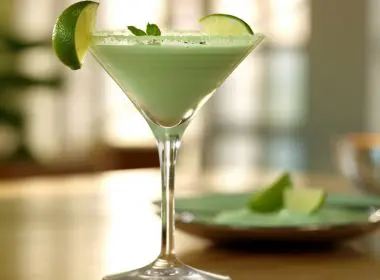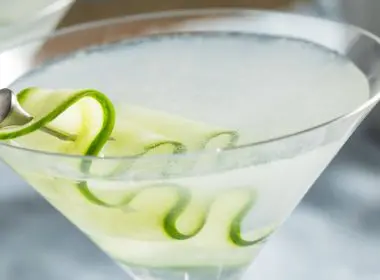Your Ultimate Guide to the Different Types of Gin
Jump to:
Ready to embark on a flavourful journey to discover different types of gin? Hop aboard, friend! Cherished by cocktail enthusiasts around the globe, this clear liquor comes in various types, each with its own captivating history and unique taste.
In this guide, we’re sharing everything you need to know about the origins and flavour profiles of each type of gin, including tasty food pairings that go with each kind. Whether you’re a seasoned gin aficionado or a curious beginner, let’s raise our glasses to the fascinating world of gin and its wide-ranging possibilities.
A short history of gin evolution
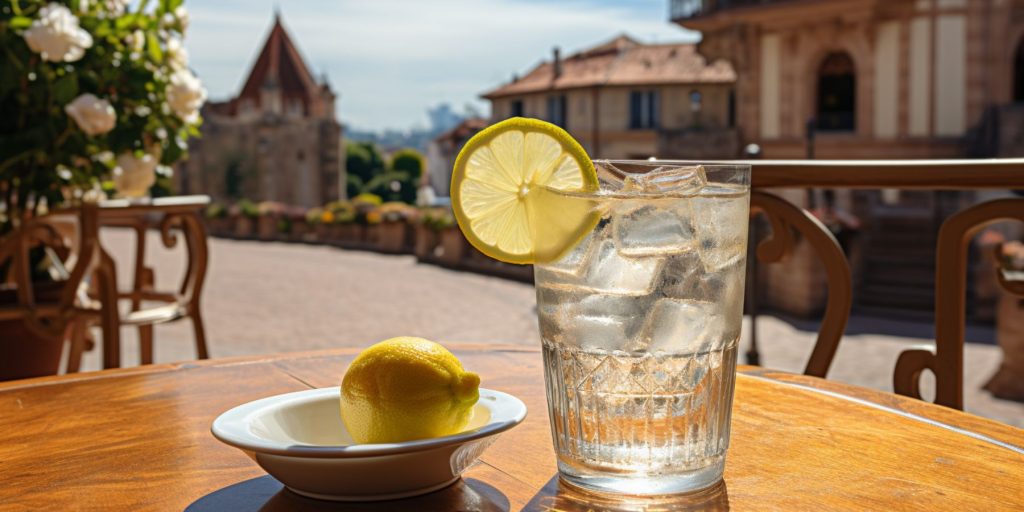
Gin has evolved significantly over time, influenced by changing rules, regulations, taxes, and trends. Historical regulations like the Gin Act of 1751 in England, which introduced higher taxes and stricter licensing laws, aimed to improve the quality of gin and ensure its responsible consumption. These changes have shaped the gin landscape, leading to the emergence of distinct varieties with unique characteristics.
Old Tom gin, known for its slightly sweeter profile, emerged as distillers refined their recipes. Sloe gin, a fruity liqueur made with sloe berries, gained popularity for its approachable taste. Plymouth gin offers a softer, more earthy flavour, distinct from the widespread London Dry gin, characterised by its crisp, juniper-forward notes. Navy Strength gin, with its higher alcohol content, traditionally required by sailing vessels, also developed as a unique category.
Geographical influence plays a significant role, with gin developing distinctive profiles in England and beyond. Despite the introduction of newer styles and nonalcoholic alternatives, traditional categories continue to maintain a strong presence in the market, reflecting gin’s rich and varied history. The ongoing innovation within the industry ensures that gin remains a dynamic and beloved spirit worldwide.
1. London dry gin

London dry gin, the stalwart of the gin world, owes its distinct character to a straightforward and carefully honed production process. Crafted through meticulous distillation, it begins with a neutral grain spirit, which serves as a blank canvas.
- How is it made? A precisely balanced blend of botanicals is introduced during distillation, ensuring a harmonious infusion of flavours. Crucially, the hallmark of London dry gin is that no artificial flavours or colours can be added after this process, preserving its purity.
- Where is it from? Originating in England, this classic gin style gained fame during the 18th century in the bustling streets of London. It played a pivotal role in shaping the global appreciation of gin and laid the foundation for the contemporary gin landscape.
- Flavour profile: Compared to other gin styles, it boasts a stronger juniper flavour, emphasising the essence of this iconic botanical. It is also typically drier, leaning heavily into botanical infusions. London dry gin is renowned for its crisp, juniper-forward taste, characterised by vibrant hints of citrus and subtle herbal notes. It’s an exceptionally clean and versatile spirit, making it the go-to choice for an array of cocktails, from timeless classics to modern clinkers.
Interestingly, despite its name, London dry gin can be produced anywhere. This flexibility allows distilleries worldwide to create their interpretations while staying true to the core principles of this timeless style.
As for pairings, The Mixer recommends:
- A classic Gin Martini with a perfectly grilled steak
- A Gin and Tonic with a medley of vegetable skewers
- A Negroni with freshly baked lemon bars for a sweet finale
Learn more: 8 Best Gins for Negroni in 2024
2. Plymouth gin

Plymouth gin, another time-honoured classic, is crafted with a distinct production process. This gin style, proudly originating from the maritime city of Plymouth in England, boasts a unique blend of botanicals.
- How is it made? Its method begins with a neutral grain spirit, just like many other gins, but here’s where it diverges: Plymouth gin incorporates a higher proportion of root botanicals. This special touch results in a slightly sweeter and earthier profile compared to its counterparts.
- Where is it from? Steeped in history, this gin type traces its roots back to the early 19th century. It found its stride in the seafaring traditions of Plymouth and quickly gained renown. This storied past is part of what makes it an emblematic choice for gin enthusiasts.
- Flavour profile: The flavor profile of Plymouth Gin is characterised by a well-balanced and smooth taste. It marries pronounced herbal and citrus notes with a touch of sweetness, offering a versatile canvas for cocktail creativity. What sets it apart is this earthy sweetness.
Unlike many other gins, Plymouth Gin is geographically protected. It can only be produced in its namesake city. This geographical distinction ensures the gin’s unique characteristics are preserved.
As for pairings, The Mixer recommends:
- A French 75 with a Full English breakfast (eggs, bacon, sausages toast, etc.)
- A Clover Club cocktail with mushroom linguini
- A Southside cocktail with chocolate-mint mousse
Read next: What is Gin Made From: The Ori(gin) Story & More
3. New American gin

New American gin brings a fresh twist to the classic spirit. Crafted with innovation and a flair for botanical diversity, it’s a gin that embodies the spirit of experimentation and creativity.
- Where is it from? Emerging in the United States during the craft cocktail renaissance of the late 20th century, New American gin is a product of the American craft distilling movement. It proudly reflects the innovation and artisanal spirit of American distillers.
- How is it made? The manufacturing process starts with the traditional neutral grain spirit base but takes a bold departure with its botanical selection. Beyond the juniper, it embraces a wide spectrum of botanicals, from exotic spices to floral elements and even unusual local ingredients. This diverse blend is carefully distilled to create a complex and dynamic flavour profile.
- Flavour profile: New American gin often delivers a medley of flavors, from citrusy and floral notes to a hint of spice. It’s a harmonious blend that’s ideal for adventurous cocktail enthusiasts. Expect a spirit that dances on the palate.
What sets New American gin apart is its creative approach to botanicals. This spirit style has gained popularity across the United States, with various distilleries putting their local spin on it. This means you can find regional variations showcasing unique botanicals or flavours.
As for pairings, The Mixer recommends:
- A Passionfruit Gin Cocktail with grilled shrimp skewers and a citrus glaze
- A Gin & Juice cocktail with a Mediterranean mezze platter
- A Strawberry Gin Cocktail with a fresh spinach and strawberry salad
Gin cocktails for every season: Summer | Winter | Christmas
4. Dry gin

Another classic in the world of spirits, dry gin is created through a meticulous process of distillation. While dry gin is traditionally associated with England, distilleries around the world produce their variations. In America, for instance, you might find dry gins with a touch of local flair, like the addition of native botanicals.
- How is it made? It starts with a neutral grain spirit, which is then infused with an array of botanicals, including juniper, coriander, and citrus peel. The defining feature is its minimal sweetness, resulting from a near absence of added sugar or flavours after distillation.
- Where is it from? Originating in Holland in the 17th century, dry gin paved the way for a lot of the gin we enjoy today. It was cherished by the British Navy for its straightforward, non-sweetened profile.
- Flavor profile: Dry gin sets itself apart with its slightly milder juniper presence and a touch less focus on botanicals, resulting in a less complex taste. This simplicity makes it a versatile choice for various cocktails, allowing the botanicals to shine through.
As for pairings, The Mixer recommends:
- A Gin Rickey with a grilled chicken salad
- A Gin Mango Cocktail alongside a fresh Caprese salad
- A Pornstar Martini served with a dish of high-quality vanilla bean ice cream +
5. Old Tom gin

Old Tom gin is made through a process similar to London dry gin, involving distillation with a mix of botanicals. It’s known for its slight sweetness, achieved through the addition of a small amount of sugar or sometimes honey after distillation.
- Where is it from? Originating in England during the 18th century, Old Tom gin has a history as rich as its flavour. It’s considered the bridge between the early Dutch gins and the London dry style, marking a crucial phase in gin evolution. While historically associated with England, Old Tom gin is also produced in the United States, where distillers may incorporate regional botanicals.
- Flavour profile: What sets Old Tom gin apart is its sweetness, making it a bit more approachable and lending a unique twist to cocktails. With a taste profile falling between the London dry and the sweeter Genever, Old Tom Gin offers a balanced blend of juniper, botanicals, and subtle sweetness. It’s a versatile choice for classic and contemporary cocktails.
The name “Old Tom” likely comes from the wooden plaques shaped like a black cat (resembling a tomcat) that were mounted on the outside of some pubs during that era.
As for pairing options, The Mixer recommends:
- A Pink Lady cocktail paired with grilled salmon and asparagus
- A Gin Sour with a spinach and mushroom quiche
- A Pegu Club cocktail alongside a slice of indulgent chocolate torte
Best of British! Feel Like Royalty with these 10 Classic British Cocktails
6. Navy strength gin

Navy strength gin, known for its robust character, shares a production process similar to other gins. It starts with distilling a neutral grain spirit, which is then infused with an array of botanicals. What sets it apart is its strength: it must clock in at a bold 57% ABV (alcohol by volume) or higher.
- Where is it from? Originating from the shores of Britain and Holland, Navy strength gin has a storied history tied to the British Royal Navy. Its high alcohol content was essential to ensure that, if spilled on gunpowder, it would still ignite—a quality that safeguarded naval supplies.
- What sets it apart? Distinguishing itself from stalwarts like London dry gin, navy strength primarily differs in strength. While London dry gin is usually bottled at 40% ABV, navy strength gin packs a more potent punch, making it ideal for cocktails that require a bold gin backbone
- Flavor profile: The flavour profile of navy strength gin is juniper-forward with an intense botanical presence, often displaying a bold and robust character that can stand up to the punch of higher-proof cocktails.
Regions around the world produce navy strength gins, but the style remains fairly consistent, with distillers focusing on achieving the high proof required.
As for pairings, The Mixer recommends:
- A Singapore Sling with a classic chicken satay
- A Ramos Gin Fizz with creamy spinach and artichoke dip and chips
7. Genever

Genever, often considered the forefather of modern gin, has a distinctive production process. It starts with a malt spirit base, akin to whiskey, infused with botanicals, including juniper and often malted barley. This creates a richer, maltier foundation.
- Where is it from? Originating in the Low Countries, Belgium, and the Netherlands, genever has deep historical roots dating back to the 16th century. It’s the bridge between gin and whiskey, as it’s closer in taste to the latter due to its malt spirit base. It’s often called the whiskey lover’s gin.
- Flavour profile: Genever’s flavour profile is a unique blend of maltiness, juniper, and subtle botanicals. It has a smoother, rounder character compared to London dry gin, with a warm, grainy essence.
While genever is typically from Belgium and the Netherlands, different regions may put their own spin on the spirit, such as using local botanicals or tweaking the malt recipe.
As for pairing options, The Mixer recommends:
- A Greyhound Cocktail with spicy barbecue chicken wings
- A Gin Gimlet with hummus, tabbouleh, and stuffed grape leaves
- A White Lady cocktail alongside a slice of apple pie (warm from the oven!)
Learn more: The Best Gin Cocktails Ever Invented
8. Flavoured gin
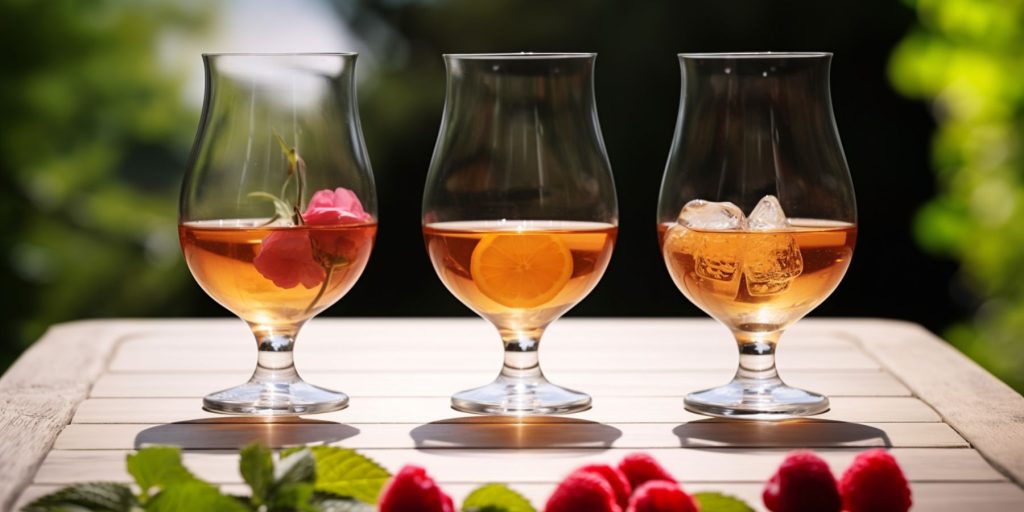
Flavoured gin, a spirited twist on the classic, is made by infusing traditional gin with various botanicals, fruits, or herbs. This infusion process imparts a burst of unique flavours to the spirit, creating a delightful variation.
- Where is it from? Originating in England, the heartland of gin, this innovative style has quickly spread its wings to become a global favourite. Its history is marked by the desire to create exciting, new taste experiences.
- What sets it apart? What sets flavoured gin apart from spirits like London dry gin is, of course, the added flavours. While London dry is juniper-forward, flavored gins offer a playful array of tastes to explore. Differences between regions often revolve around the choice of botanicals and fruits. Local ingredients can significantly influence the flavour profile, creating regional variations.
- Flavour profile: The general flavour profile of flavored gin is a harmonious blend of juniper intertwined with the specific botanical or fruit infusion. Whether it’s a burst of citrus, the warmth of spices, or the sweetness of berries, each flavoured gin tells a distinct story.
As for pairings, The Mixer recommends:
- A French Rose cocktail with seared duck breast
- A Bronx Cocktail with red pepper and goat cheese penne pasta
- A French Pearl cocktail alongside a slice of luscious plum tart
9. Japanese gin

Japanese gin, a rising star in the world of spirits, is crafted following the traditional gin-making process. It begins with a neutral base spirit, often made from rice or barley, which is then infused with a delicate selection of botanicals, including local ingredients like yuzu, cherry blossoms, and green tea.
- Where is it from? Originating in Japan, this gin style has taken root in the land of the rising sun over the past decade, gaining recognition for its precision and innovation. Japanese gin reflects the nation’s reverence for craftsmanship and nature.
- Flavour profile: What sets Japanese gin apart is its meticulous attention to detail, often resulting in a softer, more refined taste. It’s the embodiment of Japanese craftsmanship in gin form. The flavour profile of Japanese gin is a harmonious blend of juniper, citrus, and floral notes, with a touch of herbal complexity. It’s known for its subtlety and balance, making it an elegant choice for cocktails.
While Japanese gin is produced primarily in Japan, distillers may incorporate regional botanicals, giving each brand its own unique flavour signature.
As for pairings, The Mixer recommends:
- A Bee’s Knees cocktail with teriyaki-glazed chicken skewers
- A Vesper Martini alongside vegetable tempura
- A Last Word cocktail paired with mochi ice cream
More Asian inspiration: The Best Shochu Cocktails & Guide to the Famous Japanese Spirit
10. Reserve gin

Reserve gin, a distinguished member of the gin family, is crafted with a meticulous approach that involves aging the spirit in wooden barrels, much like whiskey. This aging process imparts a complexity and depth of flavour that sets it apart from its unaged counterparts.
- Where is it from? Originating in various regions, including the United States and the United Kingdom, reserve gin marries the world of gin and whiskey, resulting in a unique and refined spirit.
- How is it made? What differentiates reserve gin from other gins is its aging process, which adds layers of complexity and a whiskey-like character. While traditional gins focus on freshness, reserve gins offer a more mature and contemplative taste experience.
- Flavour profile: The flavour profile of reserve gin is marked by a delicate balance of juniper, botanicals, and the nuanced influence of the aging process. Expect notes of oak, vanilla, and sometimes a hint of smokiness.
Differences between regions can be significant, with distillers often experimenting with various wood types for aging, such as oak or chestnut, each contributing its distinct flavor.
As for pairings, The Mixer recommends:
- A Reverse Martini with seared lamb chops
- A Gin Bramble alongside a roasted vegetable tart
- A Hugo Spritz paired with a slice of bourbon-infused pecan pie
11. Sloe gin

Sloe gin is a delightful variation in the gin family, made by infusing gin with sloe berries, a small fruit related to the plum. The process involves patience as the berries are left to macerate in the gin, imparting their rich, sweet, and slightly tart flavours.
- Where is it from? Originating in England, sloe gin has a deep-rooted history, often associated with countryside traditions and hedgerow foraging. Its production pays homage to the British countryside.
- Flavor profile: What sets sloe gin apart is, of course, the star ingredient: sloe berries. This addition creates a unique, fruit-forward gin experience that’s perfect for both cocktails and sipping neat. The flavour profile of sloe gin is marked by a luscious, fruity sweetness with hints of tartness from the sloe berries. It’s a delightful departure from the usual botanical-forward gins, making it a versatile and charming choice.
Differences between regions may involve variations in the types of sloe berries used, resulting in subtle flavour distinctions.
As for pairings, The Mixer recommends:
- A Sloe Gin Fizz with a serving of pan-seared trout
- A Sloe Gin Negroni alongside a hearty vegetable risotto
- A Sloe Gin Pink Lady paired with a slice of berry cobbler and clotted cream
12. Rose gin

Rose gin, also known as pink gin, is a trendy and fragrant variation of the spirit created by infusing traditional gin with rose petals and botanicals. While its exact origin isn’t pinpointed, rose gin’s popularity has soared in recent years, capturing the essence of floral botanicals in a bottle.
- How is it made? The gin-making process remains much the same, but the addition of rose petals lends it a distinct and delicate aroma.
- Flavour profile: The flavour profile of rose gin is a harmonious blend of juniper and the subtle sweetness of rose petals, often complemented by hints of citrus or spice. It offers a refreshing and aromatic twist on traditional gin.
Differences between regions may involve the specific rose varieties or additional botanicals incorporated, contributing to nuanced flavour profiles.
As for pairings, The Mixer recommends:
- A Red Dragon cocktail with succulent honey-glazed chicken
- A Rose Gin and Tonic alongside a refreshing watermelon and feta salad
- A Sushi Rice Negroni paired with a raspberry sorbet
Read next: Fabulously Fragrant: What Are Botanicals?
How to taste gin

Now that you know more about the most popular kinds of gin from around the world, here are a few pointers about tasting it:
- Choose the right glass. Start with the right glass; a stemmed tulip-shaped glass works well. It concentrates the aromas and allows you to appreciate the gin’s nuances.
- Examine the colour. While gin is typically clear, some barrel-aged or flavoured varieties may have a subtle tint. Hold it up to the light to check for any hints of colour.
- Swirl and observe. Give your glass a gentle swirl to release the aromas. Observe the way the gin coats the sides of the glass, known as the ‘legs’. This can provide insights into the gin’s viscosity.
- Inhale the aromas. Bring the glass to your nose and take a moment to inhale the aromas. Note any herbal, citrusy, or floral scents. Swirling the glass again can intensify the aroma.
- Sip slowly. Take a small sip and let it linger on your palate. Pay attention to the flavours that unfold, from juniper and botanical notes to any hints of citrus or spice.
- Consider the finish. The finish is how the flavours linger after you swallow. Is it short and clean or long and complex? This can tell you a lot about the gin’s quality.
- Experiment. Try your gin neat, with a drop or two of water, and with different mixers. This will help you appreciate how its flavours interact in various contexts.
- Take notes. Whether mental or written, jot down your impressions. It’s a great way to remember what you like and don’t like in different gins.
Remember, tasting gin is a personal journey. There are no right or wrong ways to enjoy it. The key is to savour the experience and discover the flavors that inspire your taste buds the most.
Types of gin glasses

Wondering which glasses to use when you serve gin? Here are a few of our go-to favourites:
- Highball glass. If you’re mixing up a drink like a classic Gin and Tonic, this tall and slender glass is your best friend. It accommodates plenty of ice and allows the bubbles from the tonic to dance, creating a refreshing sip.
- Copa de Balon. Perfect for gin and tonics that are more about savouring the aroma, this bulbous glass traps the fragrances, enhancing your tasting experience. It’s also great for gin cocktails with elaborate garnishes.
- Martini glass. When it’s time for a Classic Martini, the iconic Martini glass is your choice. Its wide rim provides ample space for garnishes and allows you to savour the gin’s nuances.
- Rocks glass. If you’re serving gin neat or with a single cube of ice, this short and stout glass is the way to go. It’s all about simplicity and enjoying the spirit’s character.
- Collins glass. When crafting longer cocktails like the Tom Collins or any other tall, refreshing gin clinker, the Collins glass offers ample room for the mixers and garnishes, making it a practical choice.
- Tulip glass. This stemmed glass with a tulip-shaped bowl is excellent for neat sipping or for enjoying gin with a bit of water. It concentrates the aromas while offering an elegant touch to your experience.
How to choose the right gin
Personal preferences

Choosing the right gin can be a delightful journey, guided by your personal taste preferences. If you enjoy a slightly sweeter profile, Old Tom gin might be your perfect match. For those who appreciate fruity and approachable flavours, sloe gin is an excellent choice. If you prefer a softer, more earthy taste, Plymouth gin could be the one for you.
London Dry gin, with its crisp, juniper-forward flavour, is ideal for those who love a classic, refreshing gin experience. Navy Strength gin, known for its higher alcohol content, offers a bold and robust flavour for the adventurous gin enthusiast. Exploring different styles and brands is key to finding your favorite.
Cocktail pairings
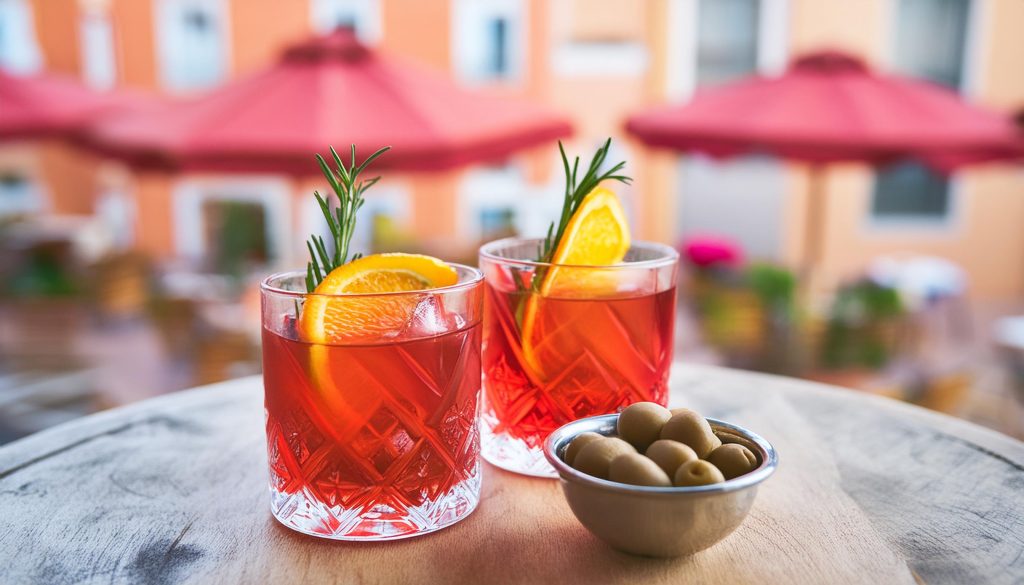
Pairing the right gin with the right cocktail can elevate your drinking experience. Here are some recommendations:
- Old Tom gin: Ideal for a Tom Collins, its sweetness balances the tartness of lemon juice.
- Sloe gin: Perfect for a Sloe Gin Fizz, where its fruity notes shine.
- Plymouth gin: Great for a classic Martini, providing a smooth and balanced flavour.
- London dry gin: Excellent for a gin and tonic or a Negroni, its juniper-forward profile stands out beautifully.
- Navy strength gin: Best for a bold Gimlet, where its robust flavour can be fully appreciated.
Experimenting with different gins and cocktails will help you discover delightful combinations that suit your palate.
There you have it – the short of the long of everything you need to know when you venture into the fascinating world of different types of gin. For more helpful insights like these, be sure to sign up for our newsletter which is crafted with care to bring you the tastiest news from around the cocktail web. Ready to start shaking, stirring, and sipping? Visit Bulldog Gin to stock up on some amazing London dry gin.







